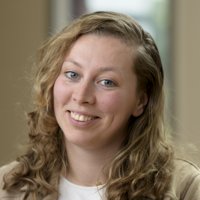Let’s Talk About Impact is a series that explores various aspects of making impact. We strive to make a change for the better, to make an impact, but what lies beyond this buzzword? Today we will talk about Open Access and Open Science. Being "open" could help make science more accessible, both for academic and general audiences alike. What would that look like, and what is happening at UT?
Open Access
 Open Access refers to publishing scientific work “open”, so not behind a paywall and accessible to a broad audience, including outside of academia. As such, Open Access publishing can increase the reach of your work and also make it reach new audiences. When looking at the numbers, we are doing well here. In 2023, BMS published 93% Open Access, through various ways. To get more insight into Open Access publishing and the possibilities, we talk to Marit van Eck (pictured), information specialist at BMS.
Open Access refers to publishing scientific work “open”, so not behind a paywall and accessible to a broad audience, including outside of academia. As such, Open Access publishing can increase the reach of your work and also make it reach new audiences. When looking at the numbers, we are doing well here. In 2023, BMS published 93% Open Access, through various ways. To get more insight into Open Access publishing and the possibilities, we talk to Marit van Eck (pictured), information specialist at BMS.
Hi Marit! I want to play a game of “true or false” to get some things clear about Open Access publishing.
Let’s do it!
True or false: Open Access publishing is expensive
False. As a UT author you can publish Open Access immediately with a licence for re-use and at no cost for you:
- in over 10.000 high-quality journals that let submitting UT authors publish OA at a 100% discount, thanks to agreements between the Universities of The Netherlands (UNL) and publishers, and
- in over 13.000 high-quality journals in the Directory of Open Access Journals (DOAJ) that don’t charge costs for OA publishing.
We advice our authors to explore one of these options before submitting your publication, the UT journal browser is the right place to find information about Open Access possibilities with scientific journals. Besides this option, we offer an extra possibility to meet 100% Open Access goal at BMS: the BMS Open Access Fund. This fund is available for all BMS corresponding authors who publish in a DOAJ indexed full Open Access journal, and offers a reimbursement per publication of €2000,-.
When both of these options aren’t available for you, there is always the possibility to rely on the Article 25fa of the Dutch Copyright Act. Thanks to this act it is possible to make the final published pdf of UT-affiliated articles, conference papers, and chapters in edited collections openly available in UT Research Information six months after the first publication date. Your eligible publications in UT Research Information will by default become open after six months, unless you opt out for one or more publications. Of course, as a UT author, it is your responsibility to make sure your publications are uploaded to Pure. The University Library does the rest.
True or false: Open Access is not just about papers
True. As you have read in the answer above, other types of scientific works can be made openly available as well. Besides the options above, there are several ways for you to open up your scientific work yourself as well. Think about pre-prints, review protocols, e.g. through Open Science Framework, but also book chapters and books. Sometimes no costs are involved because of the platform you are using to disseminate, or you can find funding for your open access goals. Either by covering it in your project budget, by finding additional Open Science funding or by – again – relying on the BMS OA fund. We are always happy to explore different options with you!
True or false: as people often call it Open Access Publishing, this must be a last step in the process, only when you are about to publish
False. Thinking about options to publish, not only about Open Access, is an essential step in your research planning. Often journals or platforms - and funders as well - require you to follow specific guidelines or take required steps during your research process in order to be able to publish with them or with their money in case of the funder. The possibility to publish Open Access is one of the things you need to plan on, and you should be aware of the different options you have and think about whether you should budget money for them. Just as you do for other parts of your research, Open Access or even better Open Science, should be considered already at the start of your project.
Open Science
 Now that we understand Open Access a bit better, it’s time to zoom out: let’s talk about Open Science. Per UNESCO: “Open science is a set of principles and practices that aim to make scientific research from all fields accessible to everyone for the benefits of scientists and society as a whole. Open science is about making sure not only that scientific knowledge is accessible but also that the production of that knowledge itself is inclusive, equitable and sustainable”. Did you know that the UT has an active Open Science Community? We asked two questions to Florian Schuberth (pictured), coordinator of the Open Science Community Twente.
Now that we understand Open Access a bit better, it’s time to zoom out: let’s talk about Open Science. Per UNESCO: “Open science is a set of principles and practices that aim to make scientific research from all fields accessible to everyone for the benefits of scientists and society as a whole. Open science is about making sure not only that scientific knowledge is accessible but also that the production of that knowledge itself is inclusive, equitable and sustainable”. Did you know that the UT has an active Open Science Community? We asked two questions to Florian Schuberth (pictured), coordinator of the Open Science Community Twente.
Hi Florian. I understand that UT has quite a large Open Science community. Why do you think people come to you? What can OSCT offer researchers?
Yes, our Open Science Community here in Twente consists of almost 200 members, mainly employees of the UT and Saxion. I think there are different reasons why people join our community. For example, (i) to be informed about OS and current practices, (ii) to discuss OS related problems with like-minded people, (iii) to learn about OS from their colleagues and/or (iv) just to get in touch with other OS enthusiasts.
We currently offer monthly events and larger annual events, often co-organized with other stakeholders such as the local Digital Competence Centre (DCC). Our last event was about Open Education at Saxion organized together with the Saxion Research Services (SRS). The events are different in character, ranging from purely informative events to hands-on events where researchers can learn new OS practices. We also send out a monthly newsletter to keep our members informed about the latest developments in the OS landscape. We also have an MS Teams environment where information can be shared and OS-related topics can be discussed. Moreover, we offer our members the opportunity to actively shape the OS landscape. For example, our members had the opportunity to comment on the NPOS Rolling Agenda. In general, we are very happy if our members want to start their own OS project and of course we offer our support. So if you have an idea, feel free to contact us!
Interesting! Can I become a member?
Joining the OSCT is easy. All you have to do is go to our website and click on “Join now!” (Alternatively, you can click here). Membership is free of charge. So I am looking forward to hopefully many new members and let’s make OS the norm at the UT.
Colophon
This series is composed by BMS Research Support. While most content applies to a wider array of disciplines, some may resonate more with a BMS audience. If you work at BMS and have any impact-related questions, reach out to Tom Boogerd. If you work at another faculty, you can still reach out and we can find a colleague of your faculty who can help.
With special thanks to:
This news item is also available as a page on our website.








